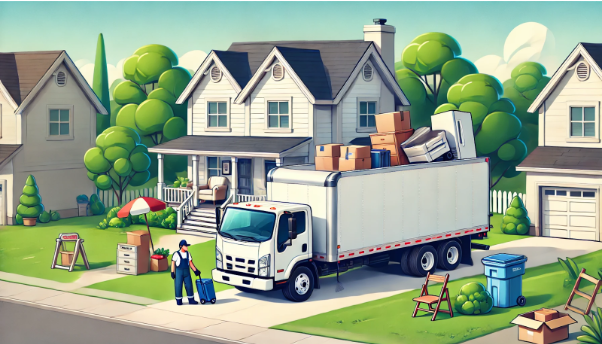
The Ultimate Guide to Household Junk Disposal: Efficient and Eco-Friendly Solutions
We’ve all been there—looking around our homes and realizing we’ve accumulated a lot more stuff than we ever intended. Whether it’s
old furniture, broken appliances, or piles of old toys, getting rid of household junk can feel overwhelming. But proper
household junk disposal
is essential not only for a tidy home but also for the environment. In this guide, we’ll explore effective strategies for disposing of household junk in an efficient,
eco-friendly manner.
Why Proper Household Junk Disposal is Important
1. Reduces Clutter and Increases Space
A clutter-free home is more enjoyable to live in and easier to keep organized. Regularly clearing out junk opens up valuable space and helps you make the most of your home.
2. Promotes Environmental Responsibility
Throwing everything in the trash isn’t sustainable. Proper junk disposal, which includes recycling and donating, helps reduce landfill waste and conserves resources.
3. Protects Your Health
Old junk like electronics, batteries, and cleaning supplies can leak harmful chemicals if not disposed of properly. Safe disposal prevents these toxins from affecting your health and the environment.
4. Improves Mental Well-Being
A clean, organized home promotes a sense of calm and reduces stress. Decluttering and disposing of household junk can be a great way to refresh your living space.
Step-by-Step Guide to Efficient Household Junk Disposal
Step 1: Assess Your Household Junk
Before diving in, take stock of the items you want to get rid of. This will help you determine the best disposal method for each item.
- Create a list: Write down items you want to keep, donate, recycle, or throw away.
- Sort items by category: Separate electronics, furniture, clothing, recyclables, and general waste.
| Category | Examples | Disposal Method |
|---|---|---|
| Recyclable | Paper, plastic bottles, metals | Curbside or recycling centers |
| Donatable | Clothing, furniture, toys | Local charities, thrift stores |
| Hazardous Waste | Batteries, paint, cleaning chemicals | Hazardous waste facilities |
| Trash | Broken items, non-recyclable plastics | General waste bin |
Step 2: Donate or Sell Usable Items
Not everything needs to end up in the trash. Donating or selling items that are still in good condition benefits others and reduces waste.
- Where to donate:
- Goodwill, Salvation Army, local shelters
- Sell items online:
- Use platforms like Craigslist, Facebook Marketplace, or eBay.
Step 3: Recycle What You Can
Recycling helps reduce landfill waste and conserves natural resources. Make sure to recycle materials like paper, cardboard, glass, and metals.
- Electronics recycling: Take old electronics to specialized e-waste recycling centers.
- Metal recycling: Scrap yards accept items like aluminum cans, old appliances, and pipes.
- Plastic recycling: Check local recycling guidelines for which plastics are accepted.
Step 4: Safely Dispose of Hazardous Materials
Certain household items require special disposal due to their hazardous nature.
- Hazardous items include:
- Paints, solvents, and adhesives
- Batteries, light bulbs, and old electronics
- Chemicals, pesticides, and cleaning supplies
- Where to dispose: Contact your local waste management facility for designated drop-off days.
Step 5: Consider Hiring a Junk Removal Service
If you have a large amount of junk or heavy items like furniture or appliances, consider hiring a professional junk removal service.
- Benefits:
- Saves time and effort
- Proper disposal and recycling of items
- Eco-friendly practices like donating and recycling usable items
Quick Tips for Reducing Household Junk Accumulation
- Adopt a One-In, One-Out Rule
- For every new item you bring into your home, get rid of one old item to prevent clutter.
- Regular Decluttering Sessions
- Schedule a decluttering session every six months to keep your home organized.
- Use Storage Solutions Wisely
- Invest in shelves, bins, and containers to keep items organized and out of sight.
- Practice Mindful Shopping
- Avoid impulse buys and focus on purchasing only what you truly need to reduce future clutter.
FAQs on Household Junk Disposal
Q1: How do I dispose of old electronics?
Electronics, also known as e-waste, contain toxic materials that shouldn’t end up in landfills. Take them to a certified e-waste recycling center.
Q2: What items cannot be recycled?
Items like plastic bags, greasy pizza boxes, and certain electronics may not be accepted in regular curbside recycling. Check your local recycling guidelines.
Q3: Can I donate broken furniture?
Most charities only accept furniture in good condition. However, some recycling centers may accept broken items for parts or recycling.
Q4: What should I do with old paint and chemicals?
Old paint and chemicals are considered hazardous waste. Contact your local waste management facility to find out how to safely dispose of them.
